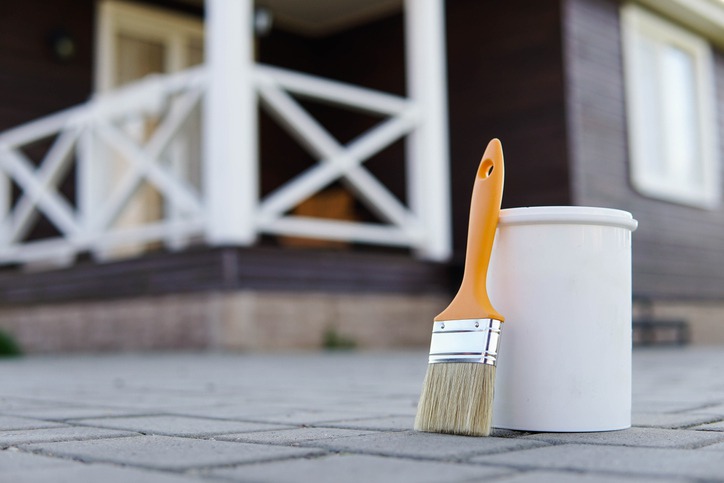Sprucing up your home’s curb appeal is one of the most exciting—and rewarding—improvements you can make as a homeowner. But deciding on the right paint or stain for your exterior isn’t just about picking a color from a swatch. There’s science, style, and a bit of savvy involved! Whether you’re about to tackle a whole-house makeover or just give your deck some love, this guide gives you the insider scoop on making smart choices. Let’s walk in so you get a beautiful finish that’s built to last.
Understanding Exterior Paint and Stain Basics
Before heading to the hardware store, it helps to know what you’re dealing with. Paint and stain are both designed to protect and beautify your home, but they do it in slightly different ways.
What Sets Paint and Stain Apart?
-
Paint: Offers a solid, opaque finish that completely covers the material beneath. It’s great for a uniform look and can hide blemishes or repairs.
-
Stain: Penetrates the surface, enhancing the wood’s natural grain and features. It provides a more natural, rustic vibe and comes in various transparencies.
Why Your Home’s Exterior Needs Protection
-
Shielding Against Weather: Rain, sunlight, and fluctuating temperatures can deteriorate wood, brick, and other surfaces.
-
Preventing Rot and Decay: Quality coatings keep mold, mildew, and damaging UV rays at bay.
-
Long-Term Value: A good finish not only looks great now but also protects your investment for years to come.
Assessing Your Substrate: Know What You’re Covering
Exterior surfaces aren’t all the same. Before making your final selection, take a close look at what you’re working with.
Common Exterior Surfaces
-
Wood: Siding, decks, trim, and fencing are often wood. Each benefits from products tailored to their porosity and vulnerabilities.
-
Masonry: Brick, stone, or stucco calls for paints with extra breathability to avoid trapping moisture.
-
Vinyl and Metal: These materials require specialty paints that adhere without peeling or bubbling.
Tips for Proper Analysis
-
Consider the age and previous treatments of your exterior.
-
Check for signs of peeling, cracking, or water damage—these indicate the need for repairs before applying a new finish.
-
If you’re unsure, a quick consultation with a local pro can give you peace of mind.
Choosing Colors and Finishes That Last
Let’s talk color—because picking the perfect hue is about more than personal taste. The right choice can elevate your home’s style and value, while the wrong one could have you headed back to the paint store prematurely.
How to Pick the Ideal Color
-
Look at your neighborhood and home style. Blending in doesn’t have to be boring, but super-bold shades on traditional houses might stand out for the wrong reasons.
-
Test in different lighting. A color that looks dreamy at sunrise might look harsh under a midday sun.
-
Factor in your roof color, landscaping, and even the pathway leading up to your front door.
Consider Durability and Finish
-
Glossy Finishes: Easy to clean and super durable, but show imperfections more easily.
-
Matte or Satin Finishes: These finishes subdue surface flaws and create a softer look, but they can be trickier to clean.
Picking the Right Product for Your Climate
Weather is a huge factor in the longevity of any exterior finish. The wrong product can age quickly if your climate isn’t considered.
How Weather Influences Your Choice
-
Hot and Sunny: Choose UV-resistant paints and stains to prevent fading.
-
Wet or Humid: Mold- and mildew-resistant formulas are a must.
-
Cold and Icy: Flexible, crack-resistant paints hold up better during freeze-thaw cycles.
Don’t Forget About Seasonal Timing
-
Exterior painting is best when temperatures are mild and humidity is low—think spring or early autumn.
-
Don’t paint right before a big rain or a heatwave, when products may not cure properly.
Preparation Makes All the Difference
Even the best paint won’t hide shoddy prep work. Ensuring your surfaces are ready can mean the difference between flawless and frustrating results.
Steps for Excellent Prep
-
Clean the surface thoroughly. Pressure wash or scrub to remove dirt, dust, and old, flaking paint.
-
Repair and sand any damaged areas. Fill cracks or holes and sand smooth for a uniform surface.
-
Prime if necessary. A primer base is needed for best results on bare wood, unpainted masonry, or drastic color changes.
Knowing Which Tools and Techniques to Use
Quality tools and good technique make exterior work far easier and more professional-looking.
Must-Have Tools
-
Brushes for trim and detailing
-
Rollers for broadsiding
-
Sprayers for large, open surfaces (and fast application!)
Application Secrets
-
Work from top to bottom to catch drips.
-
Don’t overload brushes or rollers; several thin coats are always better than a single thick one.
-
Back-brushing stain helps penetration on rough or porous surfaces like decks.
How to Make Paint Versus Stain Decisions
If you’re debating between a crisp paint finish or a natural stain, here are some quick ways to weigh your options:
Go With Paint If:
-
You want to cover imperfections
-
Your siding or trim is already painted
-
You crave bolder, uniform color
Choose Stain If:
-
You love the look of wood grain
-
Your project is a deck, fence, or other wood feature.
-
A rustic, natural appearance matches your home’s style.
Another expert tip: if your siding has seen many coats of paint over the years, it can be tricky to switch to stain without extensive prep.
If you’re feeling overwhelmed or want a professional finish, there are lots of resources available for homeowners. For more ideas or to see what’s possible, click here for more services.
Understanding Paint and Stain Types
Let’s examine popular types on the market more closely so you can make a more informed choice.
The Lowdown on Paint Types
-
Latex (Acrylic): Water-based, easy to clean, fast-drying, and eco-friendly.
-
Oil-Based: Offers a hard, durable finish but takes longer to dry and can turn yellow with age.
Stain Options Explained
-
Transparent stains show the most wood grain and need the most frequent refreshing.
-
Semi-transparent stains add subtle color and increase protection.
-
Solid stains act much like paint, covering most of the grain but not the texture.
Each type has its reapplication schedule. For high-traffic or weather-exposed areas, opt for the most protective formula.
Expert Tips for Superior Results
After years of helping homeowners get great exterior results, here are some tried-and-true tips you should never skip:
-
Test first! Always sample your finish in a small, inconspicuous spot.
-
Aim for overcast days if possible—direct sun can dry surfaces too fast, hurting adhesion.
-
Follow the manufacturer’s drying times between coats; patience pays big dividends.
-
Keep a can of paint or stain for easy touch-ups later on.
Maintenance Will Make Your Finish Last
Your work isn’t over after the last brushstroke dries. With a little routine upkeep, exterior finishes last longer and look better.
Maintenance Must-Do’s
-
Inspect annually for peeling, cracking, or faded spots.
-
Clean the exterior once or twice a year to remove grime and mildew.
-
Promptly fix issues to avoid more costly repairs down the road.
Many pros offering exterior painting services recommend scheduling touch-ups or cleaning each spring to keep things fresh and prevent costly mistakes.
Matching Products to Regional Needs
Local climate quirks and neighborhood character should always influence your decision. Suppose your home features a classic southern porch or vintage wood siding, and you are choosing products for wood staining. When it comes to wood staining in Kennesaw, GA, it’s especially important to select a process that can protect against the region’s humidity, heat, and insects while letting the charm of your home’s woodwork shine through.
Final Thoughts
With a little planning, some well-chosen products, and careful prep, your home’s exterior can look fantastic for years. Remember, the choices you make now will determine not only the beauty of your home but also its value and how much maintenance you’ll need in the future.
Whether you’re doing it yourself or hiring a trusted crew, a little research goes a long way. Good luck—your dream exterior is just a few brushstrokes away!




